Chirag Shah
I Think, Therefore I Am Under-Qualified? A Benchmark for Evaluating Linguistic Shibboleth Detection in LLM Hiring Evaluations
Aug 06, 2025Abstract:This paper introduces a comprehensive benchmark for evaluating how Large Language Models (LLMs) respond to linguistic shibboleths: subtle linguistic markers that can inadvertently reveal demographic attributes such as gender, social class, or regional background. Through carefully constructed interview simulations using 100 validated question-response pairs, we demonstrate how LLMs systematically penalize certain linguistic patterns, particularly hedging language, despite equivalent content quality. Our benchmark generates controlled linguistic variations that isolate specific phenomena while maintaining semantic equivalence, which enables the precise measurement of demographic bias in automated evaluation systems. We validate our approach along multiple linguistic dimensions, showing that hedged responses receive 25.6% lower ratings on average, and demonstrate the benchmark's effectiveness in identifying model-specific biases. This work establishes a foundational framework for detecting and measuring linguistic discrimination in AI systems, with broad applications to fairness in automated decision-making contexts.
LLM-Driven Usefulness Judgment for Web Search Evaluation
Apr 19, 2025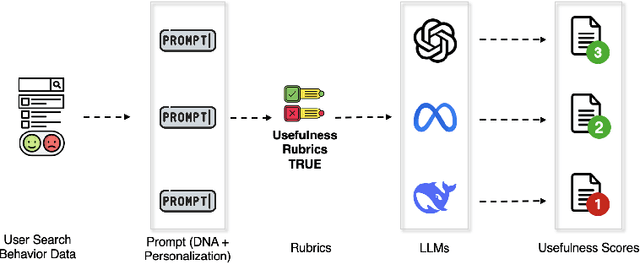

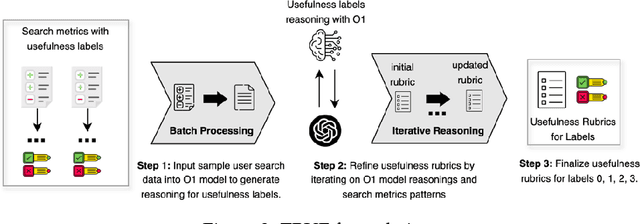
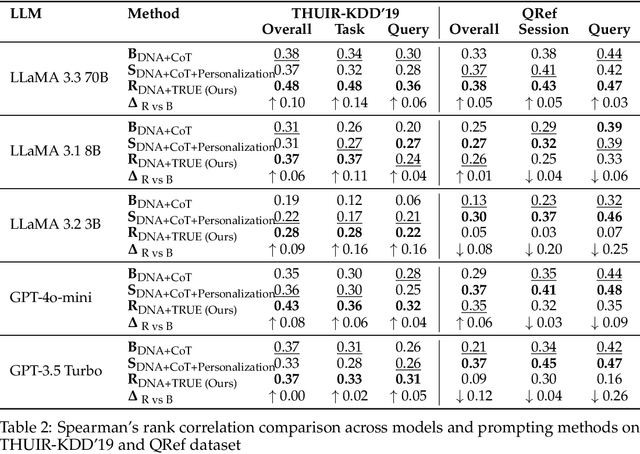
Abstract:Evaluation is fundamental in optimizing search experiences and supporting diverse user intents in Information Retrieval (IR). Traditional search evaluation methods primarily rely on relevance labels, which assess how well retrieved documents match a user's query. However, relevance alone fails to capture a search system's effectiveness in helping users achieve their search goals, making usefulness a critical evaluation criterion. In this paper, we explore an alternative approach: LLM-generated usefulness labels, which incorporate both implicit and explicit user behavior signals to evaluate document usefulness. We propose Task-aware Rubric-based Usefulness Evaluation (TRUE), a rubric-driven evaluation method that employs iterative sampling and reasoning to model complex search behavior patterns. Our findings show that (i) LLMs can generate moderate usefulness labels by leveraging comprehensive search session history incorporating personalization and contextual understanding, and (ii) fine-tuned LLMs improve usefulness judgments when provided with structured search session contexts. Additionally, we examine whether LLMs can distinguish between relevance and usefulness, particularly in cases where this divergence impacts search success. We also conduct an ablation study to identify key metrics for accurate usefulness label generation, optimizing for token efficiency and cost-effectiveness in real-world applications. This study advances LLM-based usefulness evaluation by refining key user metrics, exploring LLM-generated label reliability, and ensuring feasibility for large-scale search systems.
LLM-Driven Usefulness Labeling for IR Evaluation
Mar 12, 2025Abstract:In the information retrieval (IR) domain, evaluation plays a crucial role in optimizing search experiences and supporting diverse user intents. In the recent LLM era, research has been conducted to automate document relevance labels, as these labels have traditionally been assigned by crowd-sourced workers - a process that is both time and consuming and costly. This study focuses on LLM-generated usefulness labels, a crucial evaluation metric that considers the user's search intents and task objectives, an aspect where relevance falls short. Our experiment utilizes task-level, query-level, and document-level features along with user search behavior signals, which are essential in defining the usefulness of a document. Our research finds that (i) pre-trained LLMs can generate moderate usefulness labels by understanding the comprehensive search task session, (ii) pre-trained LLMs perform better judgement in short search sessions when provided with search session contexts. Additionally, we investigated whether LLMs can capture the unique divergence between relevance and usefulness, along with conducting an ablation study to identify the most critical metrics for accurate usefulness label generation. In conclusion, this work explores LLM-generated usefulness labels by evaluating critical metrics and optimizing for practicality in real-world settings.
Dynamic-KGQA: A Scalable Framework for Generating Adaptive Question Answering Datasets
Mar 06, 2025
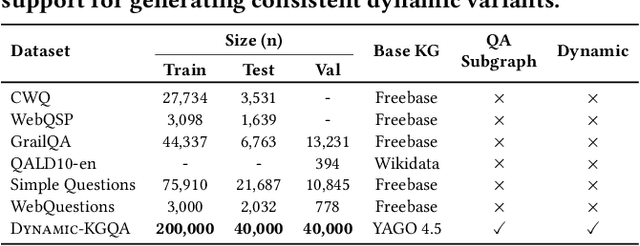

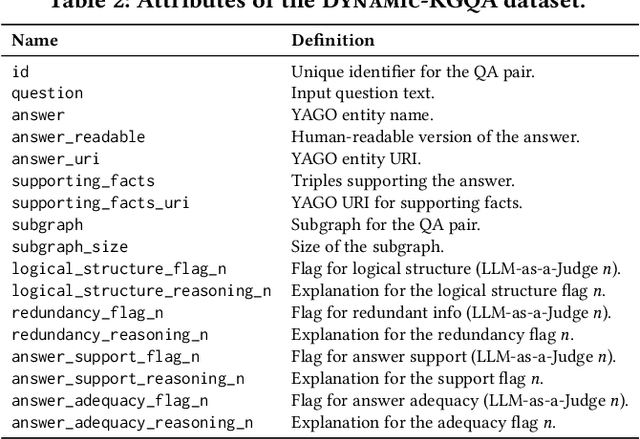
Abstract:As question answering (QA) systems advance alongside the rapid evolution of foundation models, the need for robust, adaptable, and large-scale evaluation benchmarks becomes increasingly critical. Traditional QA benchmarks are often static and publicly available, making them susceptible to data contamination and memorization by large language models (LLMs). Consequently, static benchmarks may overestimate model generalization and hinder a reliable assessment of real-world performance. In this work, we introduce Dynamic-KGQA, a scalable framework for generating adaptive QA datasets from knowledge graphs (KGs), designed to mitigate memorization risks while maintaining statistical consistency across iterations. Unlike fixed benchmarks, Dynamic-KGQA generates a new dataset variant on every run while preserving the underlying distribution, enabling fair and reproducible evaluations. Furthermore, our framework provides fine-grained control over dataset characteristics, supporting domain-specific and topic-focused QA dataset generation. Additionally, Dynamic-KGQA produces compact, semantically coherent subgraphs that facilitate both training and evaluation of KGQA models, enhancing their ability to leverage structured knowledge effectively. To align with existing evaluation protocols, we also provide static large-scale train/test/validation splits, ensuring comparability with prior methods. By introducing a dynamic, customizable benchmarking paradigm, Dynamic-KGQA enables a more rigorous and adaptable evaluation of QA systems.
Feedback-Aware Monte Carlo Tree Search for Efficient Information Seeking in Goal-Oriented Conversations
Jan 25, 2025



Abstract:The ability to identify and acquire missing information is a critical component of effective decision making and problem solving. With the rise of conversational artificial intelligence (AI) systems, strategically formulating information-seeking questions becomes crucial and demands efficient methods to guide the search process. We introduce a novel approach to adaptive question-asking through a combination of Large Language Models (LLM) for generating questions that maximize information gain, Monte Carlo Tree Search (MCTS) for constructing and leveraging a decision tree across multiple samples, and a hierarchical feedback mechanism to learn from past interactions. We present two key innovations: (1) an adaptive MCTS algorithm that balances exploration and exploitation for efficient search over potential questions; and (2) a clustering-based feedback algorithm that leverages prior experience to guide future interactions. Each incoming sample is assigned to a cluster based on its semantic similarity with previously observed samples. Our UCT (Upper Confidence bound for Trees) formulation selects optimal questions by combining expected rewards, a function of information gain, with a cluster-specific bonus that decays with depth, to emphasize the importance of early-stage questions that have proven effective for narrowing the solution space in similar samples. Experiments across three domains, including medical diagnosis and troubleshooting, demonstrate that our method leads to an average of 12% improvement in success rates and a 10x reduction in the average number of LLM calls made per conversation for the search process, in comparison to the state of the art.
Agents Are Not Enough
Dec 19, 2024Abstract:In the midst of the growing integration of Artificial Intelligence (AI) into various aspects of our lives, agents are experiencing a resurgence. These autonomous programs that act on behalf of humans are neither new nor exclusive to the mainstream AI movement. By exploring past incarnations of agents, we can understand what has been done previously, what worked, and more importantly, what did not pan out and why. This understanding lets us to examine what distinguishes the current focus on agents. While generative AI is appealing, this technology alone is insufficient to make new generations of agents more successful. To make the current wave of agents effective and sustainable, we envision an ecosystem that includes not only agents but also Sims, which represent user preferences and behaviors, as well as Assistants, which directly interact with the user and coordinate the execution of user tasks with the help of the agents.
How Many Van Goghs Does It Take to Van Gogh? Finding the Imitation Threshold
Oct 19, 2024Abstract:Text-to-image models are trained using large datasets collected by scraping image-text pairs from the internet. These datasets often include private, copyrighted, and licensed material. Training models on such datasets enables them to generate images with such content, which might violate copyright laws and individual privacy. This phenomenon is termed imitation -- generation of images with content that has recognizable similarity to its training images. In this work we study the relationship between a concept's frequency in the training dataset and the ability of a model to imitate it. We seek to determine the point at which a model was trained on enough instances to imitate a concept -- the imitation threshold. We posit this question as a new problem: Finding the Imitation Threshold (FIT) and propose an efficient approach that estimates the imitation threshold without incurring the colossal cost of training multiple models from scratch. We experiment with two domains -- human faces and art styles -- for which we create four datasets, and evaluate three text-to-image models which were trained on two pretraining datasets. Our results reveal that the imitation threshold of these models is in the range of 200-600 images, depending on the domain and the model. The imitation threshold can provide an empirical basis for copyright violation claims and acts as a guiding principle for text-to-image model developers that aim to comply with copyright and privacy laws. We release the code and data at \url{https://github.com/vsahil/MIMETIC-2.git} and the project's website is hosted at \url{https://how-many-van-goghs-does-it-take.github.io}.
How Well Do LLMs Represent Values Across Cultures? Empirical Analysis of LLM Responses Based on Hofstede Cultural Dimensions
Jun 21, 2024



Abstract:Large Language Models (LLMs) attempt to imitate human behavior by responding to humans in a way that pleases them, including by adhering to their values. However, humans come from diverse cultures with different values. It is critical to understand whether LLMs showcase different values to the user based on the stereotypical values of a user's known country. We prompt different LLMs with a series of advice requests based on 5 Hofstede Cultural Dimensions -- a quantifiable way of representing the values of a country. Throughout each prompt, we incorporate personas representing 36 different countries and, separately, languages predominantly tied to each country to analyze the consistency in the LLMs' cultural understanding. Through our analysis of the responses, we found that LLMs can differentiate between one side of a value and another, as well as understand that countries have differing values, but will not always uphold the values when giving advice, and fail to understand the need to answer differently based on different cultural values. Rooted in these findings, we present recommendations for training value-aligned and culturally sensitive LLMs. More importantly, the methodology and the framework developed here can help further understand and mitigate culture and language alignment issues with LLMs.
Do LLMs Exhibit Human-Like Reasoning? Evaluating Theory of Mind in LLMs for Open-Ended Responses
Jun 09, 2024



Abstract:Theory of Mind (ToM) reasoning entails recognizing that other individuals possess their own intentions, emotions, and thoughts, which is vital for guiding one's own thought processes. Although large language models (LLMs) excel in tasks such as summarization, question answering, and translation, they still face challenges with ToM reasoning, especially in open-ended questions. Despite advancements, the extent to which LLMs truly understand ToM reasoning and how closely it aligns with human ToM reasoning remains inadequately explored in open-ended scenarios. Motivated by this gap, we assess the abilities of LLMs to perceive and integrate human intentions and emotions into their ToM reasoning processes within open-ended questions. Our study utilizes posts from Reddit's ChangeMyView platform, which demands nuanced social reasoning to craft persuasive responses. Our analysis, comparing semantic similarity and lexical overlap metrics between responses generated by humans and LLMs, reveals clear disparities in ToM reasoning capabilities in open-ended questions, with even the most advanced models showing notable limitations. To enhance LLM capabilities, we implement a prompt tuning method that incorporates human intentions and emotions, resulting in improvements in ToM reasoning performance. However, despite these improvements, the enhancement still falls short of fully achieving human-like reasoning. This research highlights the deficiencies in LLMs' social reasoning and demonstrates how integrating human intentions and emotions can boost their effectiveness.
Panmodal Information Interaction
May 21, 2024

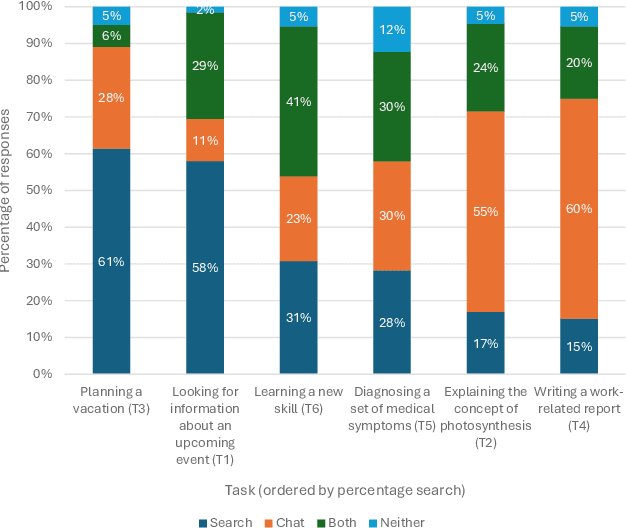
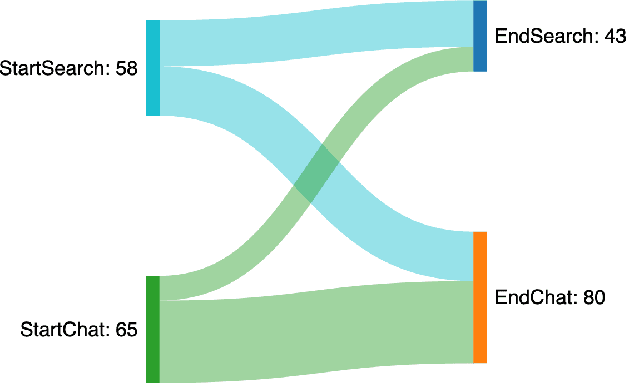
Abstract:The emergence of generative artificial intelligence (GenAI) is transforming information interaction. For decades, search engines such as Google and Bing have been the primary means of locating relevant information for the general population. They have provided search results in the same standard format (the so-called "10 blue links"). The recent ability to chat via natural language with AI-based agents and have GenAI automatically synthesize answers in real-time (grounded in top-ranked results) is changing how people interact with and consume information at massive scale. These two information interaction modalities (traditional search and AI-powered chat) coexist in current search engines, either loosely coupled (e.g., as separate options/tabs) or tightly coupled (e.g., integrated as a chat answer embedded directly within a traditional search result page). We believe that the existence of these two different modalities, and potentially many others, is creating an opportunity to re-imagine the search experience, capitalize on the strengths of many modalities, and develop systems and strategies to support seamless flow between them. We refer to these as panmodal experiences. Unlike monomodal experiences, where only one modality is available and/or used for the task at hand, panmodal experiences make multiple modalities available to users (multimodal), directly support transitions between modalities (crossmodal), and seamlessly combine modalities to tailor task assistance (transmodal). While our focus is search and chat, with learnings from insights from a survey of over 100 individuals who have recently performed common tasks on these two modalities, we also present a more general vision for the future of information interaction using multiple modalities and the emergent capabilities of GenAI.
 Add to Chrome
Add to Chrome Add to Firefox
Add to Firefox Add to Edge
Add to Edge